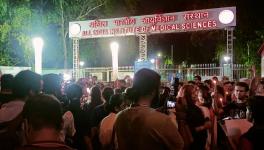Diwali at Mannat, But 3 Lakh Other Undertrial Indians Remain Incarcerated

Image for representational purpose. Credit: The Leaflet
On October 30, 2021, Aryan Khan was finally released from jail. After a month-long journey from his arrest, through the rejection of his bail pleas by special courts, to the final judgment in the High Court, the story was captured in news headlines, Twitter trends, and conspiracy theories. But what about all those individuals languishing in prison without being heard?
Over 70 percent of the prisoners in India (that is, 3,30,487 prisoners, as per National Crime Records Bureau data from 2019) are undertrials. In a criminal justice system where even straw and sipper are considered a luxury, it has become evident that the privileged will be exculpated and the weak will be incriminated.
The demographic make-up of the undertrial inmates in India shows a grim picture of society. Most of them belong to minority communities.
The 2019 NCRB statistics show that out of a total of 19,913 female prisoners, 13,550 are undertrials. A 2019 report prepared by the National Dalit Movement for Justice and the National Centre for Dalit Human Rights, titled “Criminal Justice in the Shadow of Caste” highlighted that in India, one in every three undertrial prisoners belongs either to a Scheduled Caste or Scheduled Tribe.
A story of systemic failure
The tale of an undertrial prisoner starts in a system where all organs of the State, that is, the legislature, the executive, and the judiciary, fail to provide them justice.
The recommendations made by the Law Commission of India in 2017 regarding bail reforms, warned the police against unnecessary arrests and magistrates against mechanical remand proceedings. Such a circumstance would not arise if Section 197 of the Criminal Procedure Code (CrPC) did not shield public officials even in cases involving needless arrests.
According to the section, a public official accused of committing an offense while operating in his official capacity is granted procedural immunity, and the court does not take cognizance unless previous sanction is obtained from the state or union government.
This section is a colonial vestige that the 1978 Dharamveer-led National Police Commission recommended be repealed. However, no political party has ever tried to follow through on the model police reforms suggested by the Commission.
In many cases, erroneous investigations by the police or investigating authorities lead to the prolonged pendency of trials, with little accountability.
Another deficiency in the process is the legal aid provided to these undertrial prisoners. Article 39A of the Constitution provides for free legal aid to the poor and weaker sections of society. But due to the unfavourable ratio of legal aid lawyers to the number of accused in need of services, the number of lawyers’ visits are few, and most undertrials see this option as a last resort.
Further, Section 441 of the CrPC mandates bail surety, which is provided by an indemnifier who ensures that the offender is present when the court summons him. But in most of these undertrial cases, the inmates cannot afford to arrange the surety and end up suffering for months and years in prison.
With over 4.5 crore cases pending in courts across the country, the pendency of the cases in the Indian judicial system is not a secret anymore. A halt in proceedings in a trial can range from a year to even a decade and is directly associated with a low judge-to-population ratio, which should be increased from 21.03 to 50 judges per million population. A mountain of paperwork, exacerbated by a low judge-to-population ratio only adds fuel to the fire.
Domino effect
In circumstances where the sole bread earner of a family suffers in prison, the likelihood of the family descending into vagrancy and disorder increases. Personal loss, accompanied by financial struggle and social ostracization, creates an inescapable vicious circle.
One such case is that of Vishnu Tiwari, a 43-year-old who had spent 20 years in jail on false charges of rape and offences under the Scheduled Tribes (Prevention of Atrocities) Act, 1989. Tiwari was 23 when he was first arrested, and lost both his parents during the time he was incarcerated. The family lost their ancestral land in the process of raising money to pay the lawyers, and today Vishnu has to start over, while carrying the baggage of his incarceration.
An important aspect in this regard is the viability of compensation. In its landmark judgment in the case of Rudul Sah in 1983, the Supreme Court, for the first time, awarded monetary compensation in a case involving illegal incarceration. In this case, the petitioner was wrongfully imprisoned for 14 years and was granted a compensation of INR 30,000 in addition to the INR 5,000 already paid by the State.
The apex court said:
“Article 21 which guarantees the right to life and liberty will be denuded of its significant content if the power of this Court were limited to passing orders to release from illegal detention. … Therefore, the State must repair the damage done by its officers to the petitioner’s rights. It may have recourse against those officers.
In another landmark case, Babloo Chauhan @ Dabloo vs. State Govt. Of NCT of Delhi (2017), the Delhi High Court emphasized that “there is an urgent need, therefore, for a legal (preferably legislative) framework for providing relief and rehabilitation to victims of wrongful prosecution and incarceration.”
While in the cases presented above, the courts have provided for compensation, there is an absence of a law that guides the process involved in compensation for wrongful imprisonment. This has led to a muddled and inconsistent approach by the judiciary while dealing with such cases.
In the case of Nambi Narayanan, the ISRO scientist was arrested in 1994 on charges of espionage, and finally, after a long legal battle of 24 years, in 2018, the Supreme Court awarded him INR 50 lakhs in compensation and ordered an investigation into the role of the officers involved in the conspiracy against him.
This inconsistency in judgments indicates the need for a system that legally defines and provides a mechanism for fair compensation.
The way ahead
The struggle ahead is long and bitter, but vital for a better future. In its Hussainara Khatoon (1979) judgment, the Supreme Court emphasized that a speedy trial is the fundamental right of every citizen. This judgment must be followed in letter and spirit.
Secondly, the fees given to legal aid lawyers should be standardized and paid at regular intervals in order to ensure their accountability in such matters. They must be required to regularly visit their undertrial clients and submit reports regarding the same.
Finally, the principle of “bail is the rule, jail is an exception” must be applied to overhaul a system collapsing with jammed files in the courtroom and inmates crammed into prisons.
(Shivalika Singh is a first-year law student at Jindal Global Law School. The views expressed are personal.)
Get the latest reports & analysis with people's perspective on Protests, movements & deep analytical videos, discussions of the current affairs in your Telegram app. Subscribe to NewsClick's Telegram channel & get Real-Time updates on stories, as they get published on our website.
























